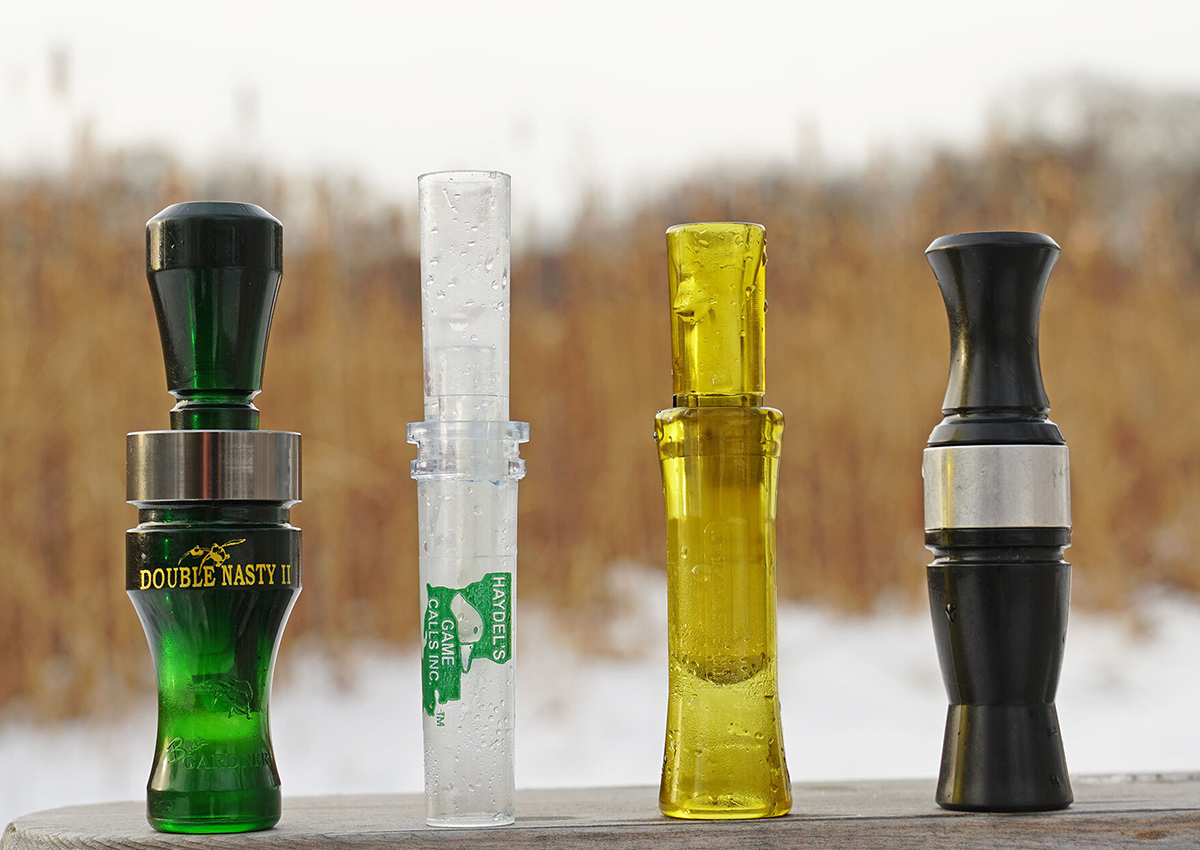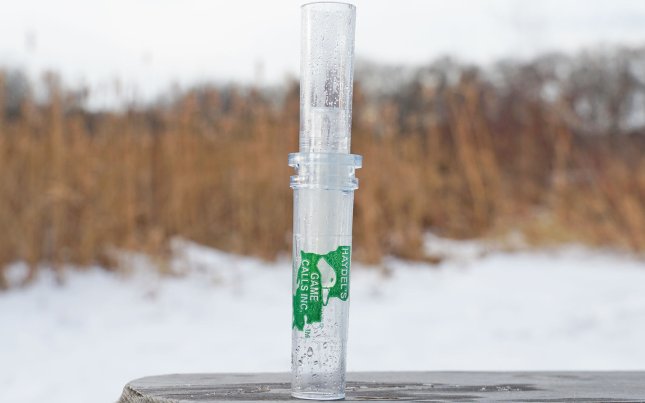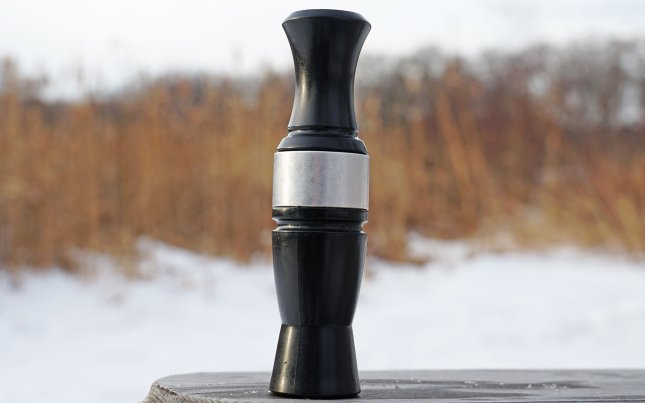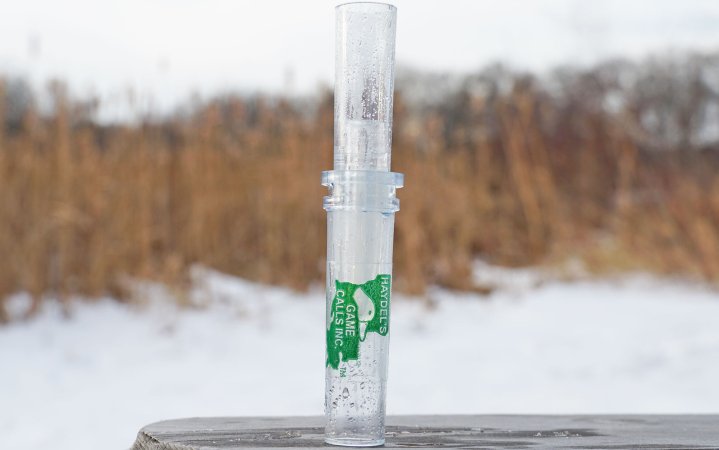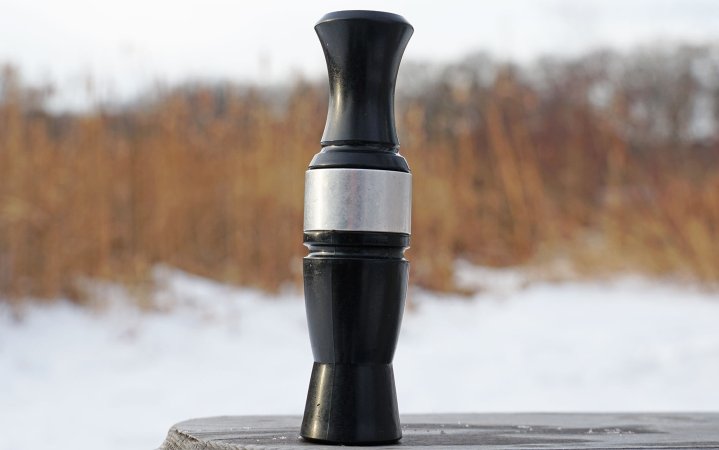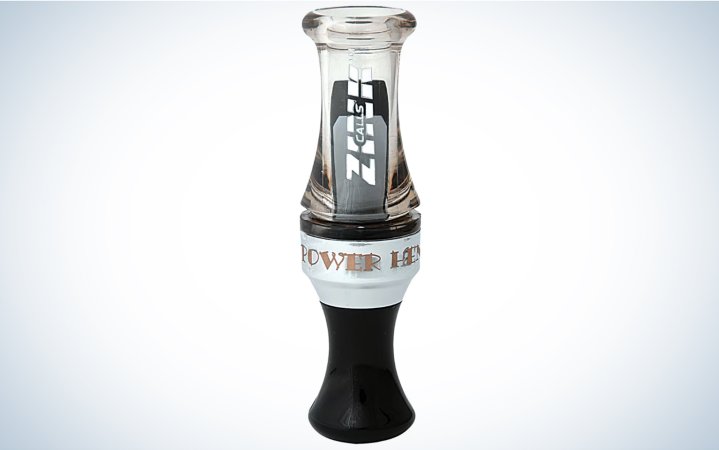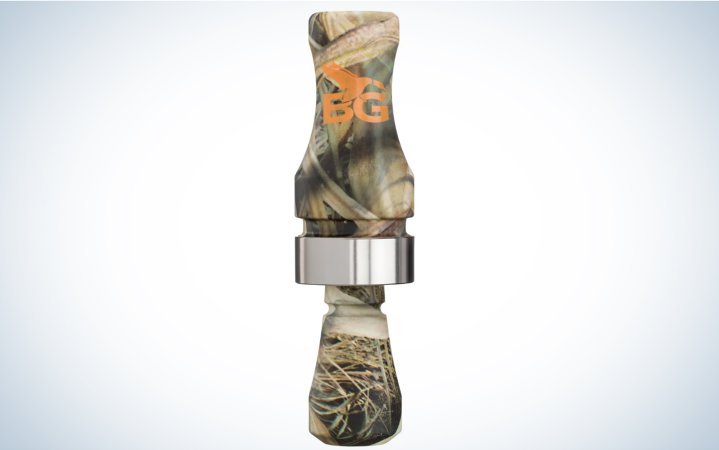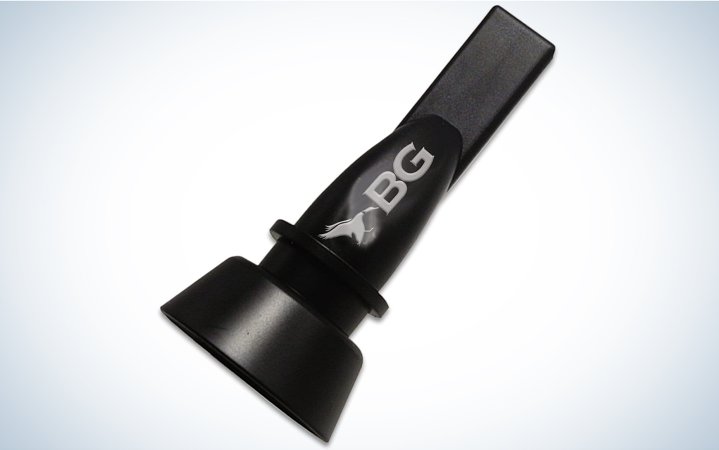We may earn revenue from the products available on this page and participate in affiliate programs. Learn More ›
Calling in a big flock of mallards, working them hard on the edges, and then finishing them over the decoys is one of the most thrilling moments in all of waterfowl hunting. But for beginners, blowing a duck call—at least in a way that sounds like a duck—can be a serious challenge.
A duck call is essentially a musical instrument, only instead of trying to play a song, you’re trying to hit the notes that will bring ducks into shotgun range. The best duck calls for beginners are easy to blow and they sound realistic. They’re also affordable and readily available at online retailers. After trying dozens of calls over decades of duck hunting, these are my top picks for the best duck calls for beginners along with audio recordings for how they sound.
Best Duck Calls for Beginners
- Best Overall: Duck Commander Triple Threat
- Easiest to Blow: Haydels DR 85
- Best Sounding: Foiles Strait Suzy
- Best Single Reed: Zink Power Hen-1
- Most Raspy: Buck Gardner Double Nasty II
- Duck Commander Wood Duck Call
- Buck Gardner 6-in-1 Whistle
Things to Consider Before Buying a Duck Call

Species
What species will you be hunting most often? If you’re like most duck hunters, a mallard call is what you want to start with. Puddle ducks and even occasionally divers will work to a mallard call. But if you hunt wood ducks specifically, or often target teal or wigeon, you’ll also want a whistle-type call.
Number of Reeds
Most duck call options will have either one or two reeds (though the Duck Commander Triple Threat has three). Reed selection all comes down to personal preference, but generally, double-reed calls are easier for beginners to use. Double reed calls do require more air pressure to blow, but they are also more forgiving. Single-reed calls have more range in pitch and volume, but they also require better mechanics and air control. If you’re getting started and just want to make realistic duck sounds, you’ll probably have an easier time with a double-reed call.
Call Material
Duck calls are commonly made from wood, polycarbonate, or acrylic. Wood is softer and more porous making softer sounds. Acrylic is denser and typically makes for louder calls (it’s also usually more expensive). Polycarbonate falls in the middle of the two. You’ll notice that most calls in this list are poly since that middle ground is a good place to start.
Cost
Custom duck calls can cost a few hundred bucks, but there’s no need for a beginner to spend that much. Going back to the musical instrument analogy, someone just learning to play guitar shouldn’t throw down for the hottest new Fender (though, if you want to spend big, here’s our review of the best duck calls). The calls in this lineup cost up to about $36. If the call you pick doesn’t work for you, that’s cheap enough that you can try another.
Best Overall: Duck Commander Triple Threat
Best Overall
Duck Commander Triple Threat
Pros
- Easy to blow
- Plenty loud
- Wide range of pitches
Cons
- On the expensive side for a beginner call
Key Features
- Material: Polycarbonate
- Reeds: 3
- Price: $36
Why It Made the Cut
This call offers a wide range of pitches and is very easy to blow.
Product Description
Jase Robertson and his buddy Steve Schultz designed the Triple Threat call over the course of a year.
“We were trying to create three reeds that are easy to blow,” Robertson says. “The more reeds you have, the more difficult it is to get the reeds to harmonize. We figured it out and the result was a unique sound.”
On the low end (less air pressure) the call sounds nice and raspy in tone, and on the high end, the call is crisp with a higher pitch that will cut through the wind. In this lineup of calls, it was the second easiest for me to blow, behind only the Haydel’s call. A call that is easy to blow is useful for beginners, but also for experienced duck hunters who want to call softly and work birds in close.
Easiest to Blow: Haydels DR 85
Easiest to Blow
Haydels DR 85
Pros
- Super easy to blow
- Realistic sound
- Affordable
Cons
- Limited volume
Key Features
- Material: Plastic
- Reeds: 2
- Price: $23
Why It Made the Cut
Even the most novice caller can put this call to their lips and sound like a duck in minutes. It takes very little air pressure.
Product Description
This is Haydel’s number one selling call for good reason: It’s incredibly easy to blow. Simply bring the call to your lips and say “hut” into the call. This call is a little higher pitched and not very gravelly, but that’s not a bad thing for new callers. It makes nice sharp quacks for greeting calls.
The DR 85 has a much smaller mouth than other duck calls, which is probably one of the reasons it’s so easy to blow: All your air is channeled through a tighter barrel. This isn’t the call I’d use to blast loud highball calls at ducks way out in the distance, but beginner duck callers shouldn’t be doing that anyway.
Best Sounding: Foiles Straight Suzy
Best Sounding
Foiles Straight Suzy
Pros
- Wide range of pitches
- Realistic sound
Cons
- Made by Jeff Foiles’ company
Key Features
- Material: Polycarbonate
- Reeds: 2
- Price: $35
Why It Made the Cut
This is the all-around best sounding call on the list.
Product Description
The Strait Suzy is my go-to mallard call season after season. It can be blown soft and raspy, but it also has enough volume and tone on the high end to talk in ducks on windy late-season hunts. Quite simply, it’s versatile and it sounds great. Beginner duck callers should go with the double-reed option. If you’re a new duck hunter who wants to take the sport seriously and get good at duck calling, this is an excellent call to learn with.
One note about this call and “lock up”: I’ve read forum postings and online reviews commenting on how this call has a tendency to stick or lock up in the cold, but I’ve never had that issue. It’s ran flawlessly for me for years.
For me, the only downside of this call is that it’s made by the company of Jeff Foiles’ who back in 2011 pled guilty to the unlawful sale of wildlife in violation of the Lacey Act, as well as one misdemeanor count of unlawfully taking migratory game birds in violation of the Migratory Bird Treaty Act.
So, if you’re going to buy this call, you might consider buying yourself an extra duck stamp (like I do each year) to help make up for Foiles’ misdeeds.
Best Single Reed: Zink Power Hen-1
Best Single Reed
Zink Power Hen-1
Pros
- Offers wide variety of tones
- Relatively easy to blow
Cons
- Will take practice to master
Key Features
- Material: Polycarbonate
- Reeds: 1
- Price: $30
Why It Made the Cut
This is an affordable single-reed call that’s easy to blow and hits a wide variety of tones
Product Description
If you’re set on a single-reed call, this is a great option. OL contributor Joe Genzel picked this call as the best value in his review of the best duck calls, and for good reason. It sounds just like a feisty suzie. The mouthpiece is flared, which makes it easier to push more air into the call and make it sound like a hen. You can run the Power Hen hard and loud without it locking up, Genzel says. You can hear him run the call in the recording below.
Most Raspy: Buck Gardner Double Nasty
Most Raspy
Buck Gardner Double Nasty
Pros
- Raspy tone
- Hand-tuned
- Personal engraving options
Cons
- Doesn’t hit high pitch notes as easily
Key Features
- Material: Polycarbonate
- Reeds: 2
- Price: $30
Why It Made the Cut
If you want that low, raspy sound of an old hen mallard, this is the call for you.
Product Description
This is probably one of the best-selling duck calls of all time. On the low end, this call sounds extra-low in pitch, and gravelly and raspy in tone. On the high end, it keeps that raspy tone throughout. This isn’t the easiest duck call on the list to blow, but it sounds great on the marsh or in the timber. According to the company, the Spit-Tech technology incorporated into this call allows it to work when wet from spit, condensation, and even accidental dips in the water. Every Double Nasty duck call is tuned by hand and tested by Buck Gardner’s staff of dedicated duck hunters in Memphis, TN.
Best Wood Duck Call: Duck Commander Wood Duck Call
Best Wood Duck Call
Duck Commander Wood Duck Call
Pros
- Cheap
- Realistic Sounding
- Easy to use
Cons
- Not versatile
Key Features
- Material: High-impact plastic
- Reeds: 1
- Price: $14
Why It Made the Cut
Woodies are surprisingly vocal ducks and will come cruising in to this call.
Product Description
This is a simple plastic call that makes squeals just like a wood duck. This is one of the best duck calls for beginners simply because many experienced duck hunters overlook it. If you’re a beginner and are hunting with a group of veterans, you might want to let them do the mallard calling (it can be nerve wracking belting out a hail call in front of a group of other hunters). But, when you see some wood ducks zipping by, don’t feel shy about hitting them with a few squeals from the Duck Commander. You just might turn’em and impress those old pros you’re hunting with.

Buck Gardner 6-in-1 Whistle
Buck Gardner 6-in-1 Whistle
Pros
- Cheap
- Versatile
- Easy to master
Cons
- Limited volume
Key Features
- Material
- Reeds:
- Price: $7
Why It Made the Cut
This is an incredibly versatile call that pairs perfectly with a standard hen mallard call.
Product Description
This call is, quite simply, a whistle. But it’s not a gimmick; it will actually kill ducks. Buck Gardner calls this a six-in-one call because it will make a pintail whistle, teal chirp, wigeon call, mallard drake call, and wood duck call. You can also use it as a whistle to bring your dog back. I’m not so sure about that last one, but I can vouch for all the others. This is one of the best duck calls for beginners because it’s incredibly easy to make the mallard drake whistle. When expert callers are working a flock, a beginner can join in and make a few mallard drake calls to add realism. Plus this is an important call to have on your lanyard if pintails start trading around.

How I Picked the Best Duck Calls for Beginners
Picking the best duck call for you all comes down to personal preference. So, I started by surfing web forums and review pages to see which calls are most commonly recommended for beginners. I then acquired all those calls (some of them I already had) and tried them out on hunts and in my backyard, which borders a duck marsh.
Calls that made the cut in this review were easy for me to blow (meaning they didn’t require a ton of air pressure), sounded realistic, and were affordable. I’m the perfect test caller for this review because I am far from an expert duck caller, but I am an experienced waterfowl hunter. I’ve hunted ducks and geese across the four flyways with some incredible callers, and some not so incredible ones. So, I’ve learned from a wide variety of different hunters. The calling you hear in these recording certainly won’t win any competitions, but it will kill ducks, and so will all of the calls in this review.
READ NEXT: How to Call Ducks and Geese

Final Thoughts
It pays to have two or three of the best duck calls for beginners on your lanyard. Over time, you’ll see which ones work the best in different scenarios.
While it’s important to try a variety of calls to get started, it’s also important to remember that as a beginner, less calling is often more effective. Think of it like traveling to a foreign country where you barely know the language. You wouldn’t shout loudly across the room, trying to string together complex sentences. No, you’d want to master a few key words and phrases and then utter them competently at the right times. Also, you’d want to do a lot of listening. The same goes for duck calling. Master the “quack” and a simple greeting call to get started. Make sure you listen to lots of real ducks and how they call to each other.

There are a ton of good calling video tutorials online, but if you use those videos alone, you’ll only learn how to sound like a duck hunter, not a duck. To sound like the real thing, you’ve got to listen to the real thing and do your best to mimic it. So, grab one or two of the best duck calls for beginners and get practicing.
